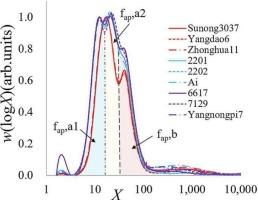三种谷类作物叶片淀粉的分子结构。
IF 12.5
1区 化学
Q1 CHEMISTRY, APPLIED
引用次数: 0
摘要
植物分别在种子和叶片中产生储藏淀粉和瞬时淀粉。了解瞬时淀粉的分子精细结构和合成有助于提高植物品质(例如,通过帮助育种者生产缓慢消化的支链淀粉,这对人类营养有益)。本研究采用氯化铯梯度离心分离法分离稻谷、小麦和大麦叶片淀粉。采用排粒径色谱法和荧光辅助碳水化合物电泳法测定淀粉的超微结构。支链淀粉在小麦和大麦叶片淀粉中的链长分布呈三峰型。叶片淀粉的全球峰值为聚合度(DP) 22,而叶片支链淀粉含有更多的长分支,这通常被认为会阻碍淀粉的消化,这表明叶片特异性淀粉合成酶可以通过基因改造在胚乳中表达,产生更多的长链支链淀粉,从而使其消化更慢,有利于人体健康。假设:在一个给定的植物物种中,叶片淀粉和储存淀粉的生物合成过程将表现出显著的差异。本文章由计算机程序翻译,如有差异,请以英文原文为准。

The molecular structure of leaf starch from three cereal crops
Plants produce storage and transient starches in seeds and in leaves, respectively. Understanding molecular fine structure and synthesis of transient starch can help improve plant quality (e.g. by helping breeders produce slowly digested amylopectin, which is beneficial for human nutrition). In the present study, leaf starches from rice, wheat and barley were isolated with cesium chloride gradient centrifugation. Starch fine structure was measured using size-exclusion chromatography and flurophore-assisted carbohydrate electrophoresis. The chain-length distribution (CLD) of amylopectin leaf starch was trimodal in wheat and barley leaf starch. The global peak of leaf starch was at degree of polymerization (DP) 22, and leaf amylopectin containeds more long branches, which are generally considered to hinder starch digestion, suggesting that leaf-specific starch synthesis enzymes could be expressed in the endosperm by genetic modification to produce amylopectin with more long chains, which would be more slowly digested, with advantages to human health.
Hypothesis
The biosynthetic processes for leaf starch and storage starch in a given plant species will show significant differences.
求助全文
通过发布文献求助,成功后即可免费获取论文全文。
去求助
来源期刊

Carbohydrate Polymers
化学-高分子科学
CiteScore
22.40
自引率
8.00%
发文量
1286
审稿时长
47 days
期刊介绍:
Carbohydrate Polymers stands as a prominent journal in the glycoscience field, dedicated to exploring and harnessing the potential of polysaccharides with applications spanning bioenergy, bioplastics, biomaterials, biorefining, chemistry, drug delivery, food, health, nanotechnology, packaging, paper, pharmaceuticals, medicine, oil recovery, textiles, tissue engineering, wood, and various aspects of glycoscience.
The journal emphasizes the central role of well-characterized carbohydrate polymers, highlighting their significance as the primary focus rather than a peripheral topic. Each paper must prominently feature at least one named carbohydrate polymer, evident in both citation and title, with a commitment to innovative research that advances scientific knowledge.
 求助内容:
求助内容: 应助结果提醒方式:
应助结果提醒方式:


